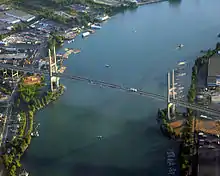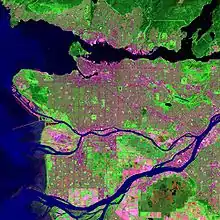Alex Fraser Bridge
The Alex Fraser Bridge (also known as the Annacis Bridge) is a cable-stayed bridge over the Fraser River that connects Richmond and New Westminster with North Delta in Greater Vancouver, British Columbia. The bridge is named for Alex Fraser (1916 – 1989), a former British Columbia Minister of Transportation. The bridge was the longest cable-stayed bridge in the world when it opened on September 22, 1986, and was the longest in North America until the Arthur Ravenel Jr. Bridge, in South Carolina, USA, opened in 2005.
Alex Fraser Bridge | |
|---|---|
 Alex Fraser Bridge | |
| Coordinates | 49.1598°N 122.9428°W |
| Carries | Seven lanes of British Columbia Highway 91, pedestrians and bicycles |
| Crosses | South Arm Fraser River |
| Locale | Delta, BC |
| Maintained by | British Columbia Ministry of Transportation |
| Characteristics | |
| Design | cable-stayed bridge |
| Material | Steel & Reinforced concrete |
| Total length | 2,525 m (8,284 ft) |
| Width | 32 m (105 ft) |
| Height | 154 m (505 ft) |
| Longest span | 465 m (1,526 ft) |
| Clearance below | 57 m (187 ft) |
| History | |
| Designer | Buckland & Taylor |
| Construction start | 1983 |
| Construction cost | $58 million |
| Opened | September 22, 1986 |
| Statistics | |
| Daily traffic | 119,000[1] |
| Location | |

| |
| References | |
| structurae.de[2] | |
Overview
The Alex Fraser Bridge is 2,525 m (8,284 ft) long with a main span of 465 m (1,526 ft). The towers are 154 m (505 ft) tall.[3] It consists of seven lanes, three in each direction with the middle lane acting as a counterflow lane, and had a maximum speed limit of 90 km per hour until July 24, 2019 when the speed limit was lowered to 70 km/h to accommodate the additional counterflow lane.[4][5] Upon opening in 1986, only four of the six available lanes were open. Cyclists and pedestrians share two narrow sidewalks one on each side. All six lanes opened in 1987 after traffic demand justified the need.[6]
The bridge's southern end is in North Delta and its northern end is on Delta's Annacis Island. Connections on its southern end lead to Blaine, Washington and to White Rock. The connections on the northern end lead into the cities of New Westminster, Richmond, and Burnaby, and on into Vancouver itself. It is a major artery in the Lower Mainland of British Columbia.
The bridge was constructed for the British Columbia Ministry of Transportation and was designed by a joint venture of Klohn Crippen Berger and Buckland & Taylor (Now COWI North America). Its total cost was $58 million.
Recent History
In December 2016 the Alex Fraser Bridge along with the Port Mann Bridge dropped "ice bombs," also called "slush bombs" on vehicles causing damage to windshields. The Alex Fraser has the cables along the sides of the driving lanes where as the Port Mann has them cross over-top of the driving lanes. In addition to 2016, this also happened on the Alex Fraser in 2005, 2008, and 2012.[7] The Alex Fraser needed to be closed a few times during December 2016 due to the possibility of ice bombs; this caused major traffic problems in the region.[8] To combat this issue, the BC Government announced that a heavy lift helicopter will be used to blow snow and ice off the cables to prevent it from accumulating and falling onto the cars below.[9]
An announcement was made on January 19, 2017, that a new seventh travel lane will be added on the bridge by slightly narrowing the existing lanes and removing the shoulders as be a joint venture by the provincial and federal government.[10] A counterflow system with movable barrier was added to help ease traffic during morning and afternoon rush hours. The new seventh lane opened to traffic on September 14, 2019,[11] with the moveable reversible zipper in operation on December 16, 2019.[12]
References
| Wikimedia Commons has media related to Alex Fraser Bridge. |
- Alex Fraser Bridge Improvement Project
- Alex Fraser Bridge en.structurae.de (in English, French, and German)
- Buckland & Taylor project page, lists design facts about the bridge
- Alex Fraser Bridge speed limit permanently lowered to 70 km/hr
- Speed limit on Alex Fraser Bridge being permanently lowered buy 20 km/h
- , The History of Metropolitan Vancouver – 1986 chronology
- Saltman, ,Jennifer. "Massey Tunnel replacement won't have ice bombs: B.C. government". www.theprovince.com. Archived from the original on 2017-02-28. Retrieved 2017-02-27.
- Tufnail, Tracey; Network, Postmedia. "Ice bombs force Alex Fraser Bridge in Vancouver to close". Toronto Sun. Toronto Sun. Retrieved 2017-02-27.
- "Helicopter to prevent snow, ice bombs falling on vehicles from Alex Fraser Bridge". Vancouver Sun. 2016-12-17. Retrieved 2017-02-27.
- Judd, Amy. "New lane to be added to Alex Fraser Bridge by narrowing existing lanes". Global News. Retrieved 2017-02-18.
- Seventh lane now open on Alex Fraser Bridge
- Alex Fraser counterflow lane sees first rush hour commute since opening
